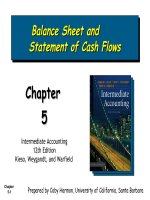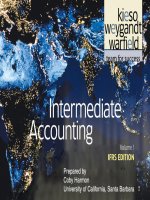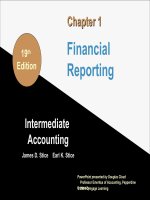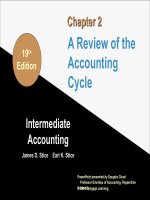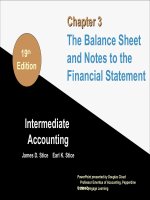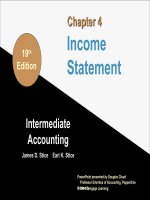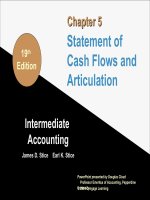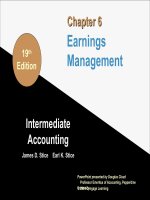Intermediate accounting 19th by stice stice chapter 05
Bạn đang xem bản rút gọn của tài liệu. Xem và tải ngay bản đầy đủ của tài liệu tại đây (320 KB, 47 trang )
Chapter 5
19th
Edition
Statement of
Cash Flows and
Articulation
Intermediate
Accounting
James D. Stice
Earl K. Stice
PowerPoint presented by Douglas Cloud
Professor Emeritus of Accounting, Pepperdine
University
© 2014 Cengage Learning
5-1
What Good is a Cash
Flow Statement?
We need the cash flow statement
because:
•
•
•
Sometimes earnings fail.
Everything is on one page.
It is used as a forecasting tool.
5-2
The Big Loss Scenario
When a company reports large noncash
expenses such as:
- write-offs
- depreciation
- provisions for future obligations
… earnings may give a gloomier picture
of current operations than warranted.
(continued)
5-3
The Rapid Growth Scenario
• Rapidly growing firms use large
amounts of cash to expand inventory.
• Cash collections on the growing
accounts receivable often lag behind the
need to pay creditors.
• Reported earnings may be positive, but
operations are actually consuming
rather than generating cash.
5-4
The Reality Check Scenario
√ Companies entering phases in which it is
critical that reported earnings look good,
accounting assumptions can be stretched
•
Just before making a large loan
application
•
Just before the initial public offering of
stock
•
Just before being bought out by another
company
(continued)
5-5
The Reality Check Scenario
• Cash flow from operations, which is not
impacted by accrual assumptions,
provides an excellent reality check for
earnings.
(continued)
5-6
Everything is on One Page
•
The cash flow statement includes
information on operating, investing, and
financing activities.
•
Everything you ever wanted to know about
a company’s performance for the year is
summarized in this one statement.
(continued)
5-7
It is Used as a
Forecasting Tool
A pro forma cash flow statement is a
prediction of what the actual cash flow
statement will look like in future years if
the operating, investing, and financing
plans are implemented.
5-8
Statement of Cash Flows
A statement of cash flows explains
the change during the period in cash
and cash equivalents.
What is this?
(continued)
5-9
Cash Equivalent
•
A cash equivalent is a short-term, highly
liquid investment that can be converted
easily into cash.
•
To qualify as a cash equivalent, an item
must be:
1. Readily convertible into cash
2. So near to its maturity that there is
insignificant risk of changes in value
due to changes in interest rates
5-10
Three Categories of
Cash Flows
•
Operating activities include those
transactions and events that enter into the
determination of net income.
Cash receipts from selling goods or from
providing services.
Receipts from Interest, dividends, and
similar items.
Payments to purchase inventory and to pay
wages, taxes, and similar expenses.
5-11
Three Categories of
Cash Flows
•
•
The primary investing activities are the
purchase and sale of land, buildings,
equipment, and other assets not generally
held for resale.
In addition, investing activities include those
transactions and events that involve the
purchase and sale of financial instruments
not intended for trading purposes, as well as
making and collecting loans.
(continued)
5-12
Three Categories of
Cash Flows
Financing activities include those transactions
and events whereby resources are obtained
from, or repaid to, owners (equity financing) and
creditors (debt financing):
• Cash proceeds from issuing stocks or bonds.
• Payments to reacquire stock (treasury stock)
or to retire bonds.
• Payment of dividends.
(continued)
5-13
Cash Flow Patterns
•
•
•
Most companies (73% in the United States
in 2006) generate positive cash flow from
operations.
In normal times, most companies use cash
to expand or enhance long-term assets, so
cash from investing activities is usually
negative (83% of the time in the United
States in 2006).
No general statement can be made about
cash flow from financing activities.
(continued)
5-14
Noncash Investing and
Financing Activities
•
•
•
Noncash investing and financing activities
affect an entity’s financial position but not the
entity’s cash flow. Examples include:
Equipment purchased with a note payable
Land acquired by issuing stock
Significant transactions should be disclosed
separately.
These transactions do not appear in the
statement of cash flows.
5-15
Operating Activities: Direct Method
• The direct method is essentially a
reexamination of each income
statement item with the objective of
reporting how much cash was received
or disbursed in association with the
item.
• To prepare the operating section, each
income statement item must be adjusted
for the effects of accruals.
5-16
Operating Activities: Indirect Method
• The indirect method begins with net
income as reported on the income
statement and adjusts the accrual
amount for any items that do not affect
cash flow.
• Both the direct and indirect methods
produce identical results—that is, the
same amount of net cash provided by
(or used in) operations.
(continued)
5-17
Operating Activities: Indirect Method
The adjustments for the indirect method are of
three basic types:
• Revenues and expenses that do not involve
cash inflow or outflow.
• Gains and losses associated with investing
or financing activities.
• Adjustments for changes in current
operating assets and liabilities that indicate
noncash sources of revenues and
expenses.
5-18
Operating Activities: Direct Method
Sales
Sales and
and Cash
Cash Collected
Collected
from
from Customers
Customers
Beginning accounts receivable
40
+ Sales
150
= Cash available for collection
$190
− Ending accounts receivable
(continued)
60
= Cash collected from customers
$
5-19
Operating Activities: Direct Method
Cost
Cost of
of Goods
Goods Sold
Sold and
and Cash
Cash
Paid
Paid for
for Inventory
Inventory
Ending inventory
75
+ Cost of goods sold
80
= Required inventory
$155
− Beginning inventory
(continued)
100
= Inventory purchased this year
$
5-20
$
Operating Activities: Direct Method
Wages
Wages Expense
Expense and
and
Cash
Cash Paid
Paid for
for Wages
Wages
Beginning wages payable
+ Wages expense
= Total obligation to employees
– Ending wages payable
10
= Cash paid for wages
$ 7
25
$32
$22
(continued)
5-21
Operating Activities: Direct Method
Depreciation
Depreciation Expense
Expense
5-22
Operating Activities: Indirect Method
Sales
Sales
The $20 increase in accounts receivable
means that cash collected is $20 less than
the $150 the sales number indicates. So,
the necessary adjustment is to subtract
the $20 to show that $130 was collected
on account.
(continued)
5-23
Operating Activities: Indirect Method
Cost
Cost of
of Goods
Goods Sold
Sold
The $25 decrease in inventory means that
although cost of good sold of $80 is
included in the income statement, less
cash was used to purchase inventory than
suggested—add $25 to net income.
(continued)
5-24
Operating Activities: Indirect Method
Wages
Wages Expense
Expense
The $3 increase in wages payable
indicates that only $22 of the $25 expense
was paid in cash. The $3 increase in
wages payable is added to net income.
(continued)
5-25
